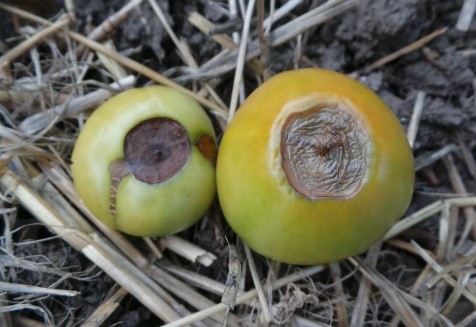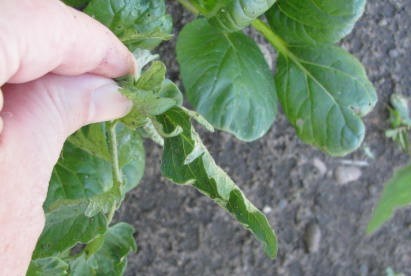Margaret Murphy
Horticulture Educator for Chippewa, Dunn, & Eau Claire Counties
UW-Madison Extension
As we finish out July and head into August, gardeners are looking forward to harvesting their tomatoes. Tasting that first, freshly picked tomato is a joy every tomato grower knows. But this is also the time to keep a look out for some common disorders that may show up on tomato plants. These are issues not caused by disease but rather by environmental stresses.

One common disorder is blossom end rot. Blossom end rot is characterized by a sunken, dark area at the blossom end of the tomato. It often occurs on developing fruit during times of hot, dry weather. It tends to have the greatest impact on the earliest-maturing fruit. Blossom end rot results from the plant being unable to provide enough calcium to the fruit as its growing. Calcium can become deficient when there is a wide fluctuation in soil moisture. Although blossom end rot means that the plant does not have enough calcium within the developing fruit, it does not necessarily mean that there is a lack of calcium in the soil.
The best way to prevent blossom end rot is to avoid uneven watering. Consistent, uniform watering will help keep a steady flow of calcium from the soil to the fruit. Apply mulch to retain soil moisture between watering and avoid large applications of nitrogen fertilizer. As mentioned, it’s the first fruit formed that is usually affected, fruit that develops later in the season on the same plant can be fine. To learn more about blossom end rot, visit https://pddc.wisc.edu/2015/07/06/blossom-end-rot/.

Fruit cracking is another common problem associated with large variations in soil moisture. Growth cracks result from rapid fruit development and can occur when water is suddenly available to the plant by either rain or irrigation after a period of extended dryness. There are two types of cracks generally observed: radial and concentric. Radial cracks spread out from the stem while concentric cracks appear on the shoulders of the tomato forming arcs or circles. As with blossom end rot, providing even moisture by watering regularly and by mulching can help reduce growth cracks.
Sunscald is a condition we might also see on tomatoes during the summer. It appears as a bleached area on the skin that, in time, may become a flattened or slightly sunken area with a pale yellow, wrinkled appearance. It results from fruit being suddenly exposed to direct sun, which can occur from pruning or loss of foliage due to disease or insect damage. To prevent sunscald, maintain healthy foliage by controlling for foliar diseases and insects and avoid excess pruning or shoot removal.

Another condition I have seen lately is leaf roll. This involves the leaf edges rolling upward until they touch or overlap with each other. Common in hot, dry weather, it is thought to also be caused by fluctuations in soil moisture but can occur due to other stresses. Leaf roll is not known to reduce growth or fruit quality. Once leaves roll they may not unroll. Not all tomato varieties are equally susceptible to leaf roll so it may show up on some plants and not others.
Most of the disorders mentioned can be helped or prevented by adequate and consistent watering. So, to help our tomato plants through these ‘dog days of summer’, give plants at least an inch of water once a week. Moisten the root zone by watering the soil around the base of the plant. Mulching is also important. Mulch helps to control weeds that compete for water and nutrients and conserves soil moisture. Mulch should cover the soil around your tomato plants at a depth of two to three inches. If the material compacts easily, such as with grass clippings, make the mulch layer thinner.
Photo Credits: Photo 1 & 2, Susan Mahr, UW – Madison Extension. Photo 3, Margaret Murphy.




